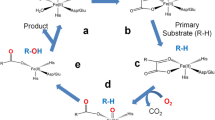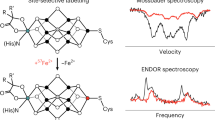Abstract
The interactions of Mn2+ and Co2+ with glucose isomerases from three microbial sources have been studied using various direct physical methods. Co2+ was found to activate each enzyme, although the degree of activation varied significantly for enzymes from different organisms. EPR spectroscopy measurements revealed that dissimilarities in the coordination sphere of enzyme-bound Mn2+ accompanied the differences in enzyme activity. Variations in the EPR spectra of a nitroxide spin label coupled to two of the three isomerases, possibly near their active sites, were also observed. In no case was the EPR spectrum influenced by Co2+ addition, a result discordant with the hypothesis that Co2+ activates the enzyme by inducing a conformational change. The proximal biochemical environment of enzymebound Co2+ was also examined using EXAFS spectroscopy. This method showed that glucose causes notable changes in the ligand environment of the enzyme-bound metal, suggesting the formation of an enzyme-metal-substrate bridge complex. The significance of these results relative to possible reaction mechanisms is discussed.
Similar content being viewed by others
References
Crueger, W.; Crueger, A. 1984: Biotechnology: A textbook of industrial microbiology. Madison: Science Tech., Inc.
Bucke, C. 1983: There is more to sweeteners than sweetness. Trends Biotechnol. 1, 67–69
Antrim, R. L.; Colilla, W.; Schnyder, B. J. 1979: Glucose isomerase production of high-fructose syrups. In: Wingard, Jr., L. B.; Katchalski-Katzir, E.; Goldstein, L. (Eds.): Applied Biochemistry and Bioengineering, vol. 2, Enzyme Technology, pp. 97–155. New York: Academic Press
Danno, G. 1971: Studies on D-glucose-isomerizing enzyme from Bacillus coagulans, Strain HN-68. Agric. Biol. Chem. 35, 997–1006
Young, J. M; Schray, K. J.; Mildvan, A. S. 1975: Proton magnetic relaxation studies of the interaction of D-xylose and xylitol with D-xylose isomerase. J. Biol. Chem. 250, 9021–9027
Mildvan, A. S.; Rose, I. A. 1969: NMR and stereochemical studies of the mechanism of D-xylose isomerase. Federation Proc. 28, 534
Mildvan, A. S. 1970: Metals in enzyme catalysis. In: Boyer, P. D. (Ed.): The enzymes, Student Ed., vol. 2, p. 511. New York: Academic Press
Reed, G. H.; Markham, G. D. 1984: EPR of Mn(II) complexes with enzymes and other proteins. In: Berliner, L. J.; Reuben, J. (Eds.): Biological Magnetic Resonance, vol. 6, pp. 73–142. New York: Plenum Press
Bailey, J. E.; Clark, D. S.: EPR studies of immobilized chymotrypsin. In: Mosbach, K. (Ed.): Methods in enzymology, in press. New York: Academic Press
Morrisett, J. D. 1976: The use of spin labels for studying the structure and function of enzymes. In: Berliner, L. J. (Ed.): Spin labeling: theory and applications, pp. 273–338. New York: Academic Press
Clark, D. S.; Bailey, J. E. 1983: Structure-function relationships in immobilized chymotrypsin catalysis. Biotechnol. Bioeng. 25, 1027–1047
Clark, D. S.; Bailey, J. E. 1984: Characterization of heterogeneous immobilized enzyme subpopulations using EPR spectroscopy. Biotechnol. Bioeng. 26, 231–238
Clark, D. S.; Bailey, J. E. 1984: Deactivation kinetics of immobilized α-chymotrypsin subpopulations. Biotechnol. Bioeng. 26, 1090–1097
Hoschke, A.; Balogh, K.; Laszlo, E.; Hollo, E. 1984: Determination of functional groups in glucose isomerase. Starch/Starke. 36, 26–30
Cramer, S. P. 1979: Structure determination by X-ray absorptin spectroscopy — including applications from the study of molybdenum proteins. In: Castellani, A.; Quercia, I. F. (Eds.): Synchrotron radiation applied to biophysical research, pp. 291–322. New York: Plenum Press
Lytle, F. W.; Sagers, D. E.; Stern, E. A. 1982: The history and modern practice of EXAFS spectroscopy. In: Bonnelle, C.; Mande, C. (Eds.): Advances in X-ray spectroscopy, pp. 267–286. New York: Pergamon Press
Bock, K.; Wiebe, L. 1983: Report on the enzyme catalyzed conversion of D-glucose into a mixture of D-glucose and D-fructose. Acta Chem. Scand. Ser. B37, 101–108
Author information
Authors and Affiliations
Rights and permissions
About this article
Cite this article
Branner, S., Marg, G., Ozer, R. et al. EPR and EXAFS studies of glucose isomerase activation by divalent metals. Bioprocess Engineering 1, 71–77 (1986). https://doi.org/10.1007/BF00387498
Received:
Issue Date:
DOI: https://doi.org/10.1007/BF00387498




